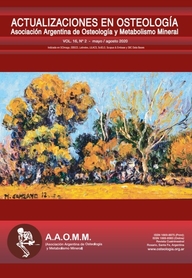Rol de los fitoestrógenos en la calcificación vascular e interacciones óseo-vasculares
Autores: Marisa Julia Sandoval, Sabrina Belén Cepeda, Virginia Laura Massheimer
Resumen
La osteoporosis y las enfermedades cardiovasculares son patologías prevalentes en mujeres posmenopáusicas. La calcificación vascular es un proceso en el que se produce una distorsión de la arquitectura natural del tejido arterial con una transformación símil osteogénica. La fisiología vascular y la osteogénesis (formación y remodelación ósea) comparten una complejidad metabólica y funcional crítica, que ha sido poco explorada en forma conjunta, lo que ha impulsado la concepción del Eje Óseo-Vascular como nueva área de investigación, con una visión de estudio integradora con la finalidad de identificar vínculos entre ambos sistemas. En virtud de la controversia planteada sobre los riesgos/ beneficios de la terapia de reemplazo hormonal para prevenir enfermedades asociadas a la menopausia, se ha incentivado la búsqueda de nuevas opciones de tratamiento. Los fitoestrógenos, como compuestos nutracéuticos, surgen como una potencial alternativa terapéutica. En particular, las isoflavonas presentan gran analogía estructural con el estrógeno humano 17β-estradiol, lo que les permite
unirse al receptor de estrógenos e inducir acciones estrogénicas tanto en células animales
como humanas. Basado en la experiencia propia como en lo reportado en la bibliografía, este artículo analiza la información disponible sobre las acciones vasculares y óseas de los
fitoestrógenos (específicamente la isoflavona genisteína), con una visión de ciencia traslacional.
Es de esperar que los avances en el conocimiento derivado de la ciencia básica, en un futuro cercano, pueda contribuir a decisiones clínicas a favor de promover terapias naturales de potencial acción dual, para la prevención de enfermedades de alta prevalencia y significativo costo social y económico para la población.
Palabras clave: fitoestrógenos, genisteína, calcificación vascular, osteoblastos, eje óseovascular.






